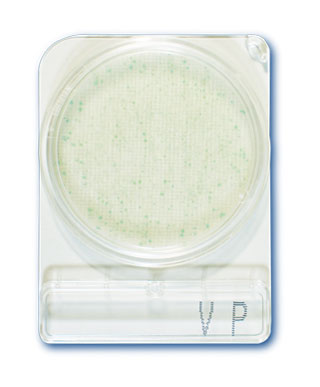Compact Dry VP
- Ready and easy to use portable plate: Preparation of medium is not required, which eliminates waste of medium as well as sterilizing apparatus to prepare the medium.
- Detection of colonies on plate is simple and clear.
- Single colonies on the plate can be isolated for further identification tests
Ready-to-use petri dishes for reliable microbiological analysis for Vibrio parahaemolyticus.
Vibrio parahaemolyticus is a bacterium that can cause cholera. Vibrio parahaemolyticus-associated gastroenteritis is the infection caused by this organism. Vibrio parahaemolyticus naturally inhabits coastal waters and is present in higher concentrations during the summer; it is a halophilic, or salt-requiring organism. Vibrio parahaemolyticus is found in marine environments, sea foods, and the feces of patients with acute enteritis. Compact Dry VP can not only easily detect Vibrio parahaemolyticus, but also differentiate Vibrio parahaemolyticus from other vibrios. The product contains a specific chromogenic substrate for Vibrio parahaemolyticus which develops blue/green or blue colonies, whereas other vibrios develop white colonies.
Incubation time and temperature: 20 - 24 hours at 35 - 37 °C
Shelf life: 16 months after manufacturing
Storage: Room temperature (+ 1 to 30 °C).
Sample pretreatment
Viable count in water or liquid foodstuff
Drop 1 ml of specimen (dilute if necessary) on the middle of the Compact Dry plate.
Viable count in solid foodstuff
Add buffer solution to the sample and homogenize by stomacher®. Drop 1 ml of specimen (dilute if necessary) on the middle of the dry sheet of the Compact Dry plate.
Viable count in swab test specimen
Use the swab to wipe the surface, put into the device with wiping solution. Drop 1 ml of wiping solution (dilute if necessary) on the middle of the Compact Dry plate. It is recommended to use “Swab for Compact Dry” offered by HyServe Id-No. 1 002 952/3 (40/240 pieces)
Test instructions
1. Open the cap and drop 1 ml of specimen on the middle of the Compact Dry plate.
2. Specimen diffuses automatically and evenly into the sheet and transforms the dried sheet into a gel within seconds.
3. Put the cap again on the plate and write the information needed on the memorandum section.
4. Turn over the capped plate and put in the incubator.
5. After incubation count the number of colored colonies underneath the plate. White paper placed under the plate helps to count the colonies.
